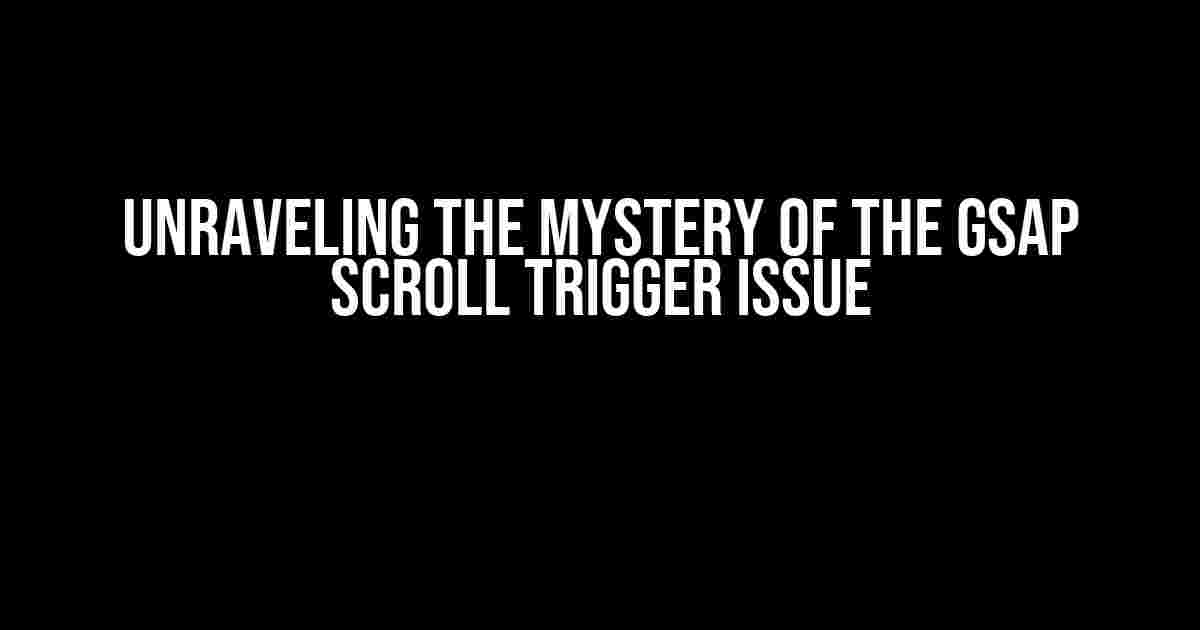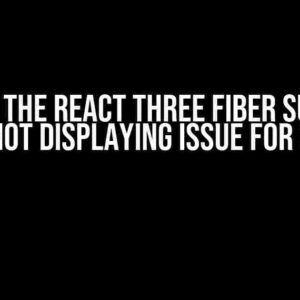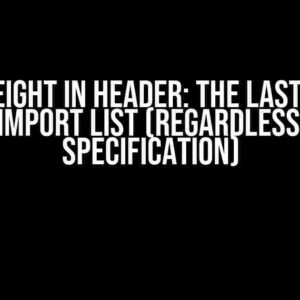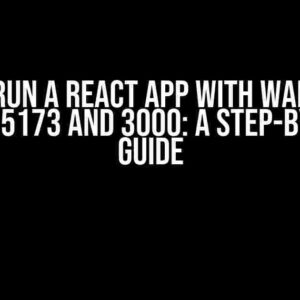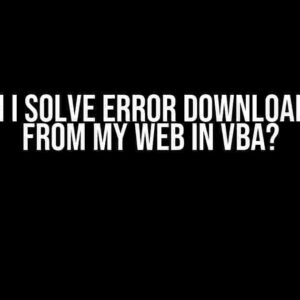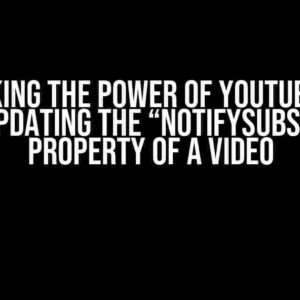Are you tired of wrestling with the GSAP scroll trigger issue, only to end up with a tangled mess of code and aching frustration? Fear not, dear developer, for we’re about to dive headfirst into the world of GreenSock Animation Platform (GSAP) scroll triggers and unravel the mysteries that have been plaguing you.
What is the GSAP Scroll Trigger Issue?
The GSAP scroll trigger issue refers to the unexpected behavior of scroll-triggered animations, where the animation doesn’t behave as intended, often resulting in janky or irregular motion. This issue can manifest in various ways, including:
- Inconsistent animation speed
- Jumping or stuttering animations
- Animations not triggering on scroll
- Animations triggering multiple times on a single scroll event
In this article, we’ll explore the common causes of the GSAP scroll trigger issue, provide clear and actionable solutions, and arm you with the knowledge to tackle even the most complex scroll-triggered animations.
scrollTrigger Basics
Before diving into the issue itself, let’s take a brief look at the scrollTrigger plugin, which is the root of our problems (and solutions). The scrollTrigger plugin allows you to trigger animations on scroll events, enabling creating engaging and interactive experiences.
import { gsap } from "gsap";
import { ScrollTrigger } from "gsap/ScrollTrigger";
gsap.registerPlugin(ScrollTrigger);
const animation = gsap.timeline();
animation.to(".element", { x: 100 });
ScrollTrigger.create({
animation: animation,
trigger: ".trigger-element",
start: "top center",
end: "bottom center",
scrub: true,
});In this example, we’re creating a basic scroll-triggered animation using the ScrollTrigger plugin. The animation is triggered when the user scrolls the page, and the trigger element reaches the top center of the viewport.
Common Causes of the GSAP Scroll Trigger Issue
Now that we’ve covered the basics, let’s explore the common causes of the GSAP scroll trigger issue:
1. Improper Trigger Element Size
One of the most common causes of the GSAP scroll trigger issue is an incorrectly sized trigger element. When the trigger element is too small, it can lead to inconsistent animation triggering, while a too-large trigger element can cause animations to trigger multiple times on a single scroll event.
To avoid this issue, ensure that your trigger element is sized correctly, taking into account the animation’s start and end points.
2. Inadequate scrub Configuration
The scrub property is crucial for smooth scroll-triggered animations. When scrub is set to true, GSAP will smoothly update the animation based on the scroll position. However, when scrub is set to false, the animation will jump to the end of the animation when the trigger element reaches the end of the viewport.
To fix this issue, ensure that you’re using the correct scrub configuration for your animation.
3. Conflicting Animation Timelines
When multiple animations are triggered simultaneously, it can lead to conflicts and unexpected behavior. This is particularly common when using multiple ScrollTrigger instances on the same page.
To avoid this issue, ensure that you’re using unique animation timelines and carefully manage the triggering of multiple animations.
4. Incorrect start and end Points
The start and end points of the ScrollTrigger plugin determine when the animation is triggered. When these points are incorrectly configured, it can lead to unexpected animation behavior.
Ensure that you’re using the correct start and end points for your animation, taking into account the trigger element’s position and the animation’s duration.
Solutions to the GSAP Scroll Trigger Issue
Now that we’ve identified the common causes of the GSAP scroll trigger issue, let’s explore the solutions to these problems:
1. Use the markers Property
The markers property allows you to visually debug your scroll-triggered animations, providing a clear understanding of the animation’s start and end points.
ScrollTrigger.create({
animation: animation,
trigger: ".trigger-element",
start: "top center",
end: "bottom center",
scrub: true,
markers: {
start: " Start",
end: " End"
}
});By adding the markers property, you can easily identify the animation’s start and end points, ensuring that your trigger element is correctly sized and configured.
2. Implement a Debounce Function
A debounce function can help prevent multiple animation triggers on a single scroll event. This is particularly useful when dealing with large or complex animations.
let debounceTrigger = null;
ScrollTrigger.addEventListener("scroll", () => {
debounceTrigger = setTimeout(() => {
animation.play();
}, 100);
});
ScrollTrigger.addEventListener("scrollEnd", () => {
clearTimeout(debounceTrigger);
});By implementing a debounce function, you can ensure that your animation is triggered only once per scroll event, preventing unwanted multiple triggers.
3. Use a Single Animation Timeline
When working with multiple animations, it’s essential to use a single animation timeline to manage the triggering of each animation.
const masterTimeline = gsap.timeline();
masterTimeline.add(animation1);
masterTimeline.add(animation2);
masterTimeline.add(animation3);
ScrollTrigger.create({
animation: masterTimeline,
trigger: ".trigger-element",
start: "top center",
end: "bottom center",
scrub: true,
});By using a single animation timeline, you can ensure that your animations are triggered in the correct order and prevent conflicts between multiple animations.
4. Configure the scroller Property
The scroller property allows you to specify the element that should be used for scrolling. This can be particularly useful when working with complex layouts or nested scrolling elements.
ScrollTrigger.create({
animation: animation,
trigger: ".trigger-element",
start: "top center",
end: "bottom center",
scrub: true,
scroller: "#scroll-container"
});By configuring the scroller property, you can ensure that your animation is triggered correctly, even in complex scrolling scenarios.
Best Practices for Avoiding the GSAP Scroll Trigger Issue
To avoid the GSAP scroll trigger issue altogether, follow these best practices:
- Use a clear and consistent naming convention for your trigger elements and animations.
- Ensure that your trigger element is correctly sized and positioned.
- Use the
markersproperty to visually debug your scroll-triggered animations. - Implement a debounce function to prevent multiple animation triggers on a single scroll event.
- Use a single animation timeline to manage the triggering of multiple animations.
- Configure the
scrollerproperty to specify the correct scrolling element. - Test your scroll-triggered animations thoroughly to ensure that they’re working as intended.
Conclusion
The GSAP scroll trigger issue can be a frustrating and daunting problem, but with the right knowledge and tools, you can overcome even the most complex animation challenges. By understanding the common causes of the issue and implementing the solutions outlined in this article, you’ll be well on your way to creating seamless and engaging scroll-triggered animations.
| Solution | Description |
|---|---|
Use the markers property |
Visually debug your scroll-triggered animations |
| Implement a debounce function | Prevent multiple animation triggers on a single scroll event |
| Use a single animation timeline | Manage the triggering of multiple animations |
Configure the scroller property |
Specify the correct scrolling element |
Remember, with patience, practice, and a solid understanding ofHere are 5 Questions and Answers about “Gsap Scroll Trigger Issue” in a creative voice and tone:
Frequently Asked Question
Get ready to troubleshoot like a pro! We’ve got the most common GSAP Scroll Trigger issues covered, so you can get back to animating like a boss!
Why isn’t my scroll trigger working at all?
Check if you’ve forgotten to add the `scrollTrigger` property to your tween! It’s an easy mistake, but it’ll keep your animation from working altogether. Make sure to add it and voilà! Your scroll trigger should start working as expected.
My animation only plays once, why isn’t it looping?
It’s likely because you haven’t set the `scrub` property to `true`! This property tells GSAP to re-run the animation whenever the user scrolls back up to the trigger point. Without it, the animation will only play once and then stop. Simple fix, right?
How do I get my animation to play in reverse when the user scrolls back up?
Easy peasy! You just need to set the `reverse` property to `true` on your scroll trigger. This tells GSAP to play the animation in reverse when the user scrolls back up to the trigger point. Boom!
Why is my animation jumping all over the place when I scroll?
Whoa, that does sound crazy! This might be due to not setting a clear `start` and `end` value for your scroll trigger. Make sure to define when you want the animation to start and end, and GSAP will take care of the rest. Smooth sailing!
Can I use multiple scroll triggers on the same page?
Absolutely! You can have as many scroll triggers as you need on the same page. Just make sure to give each trigger a unique `id` and GSAP will handle the rest. Go wild and create an animation extravaganza!

